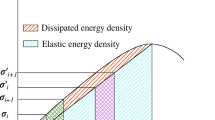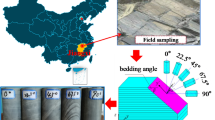Abstract
Energy accumulation and energy release are typical characteristics during the whole deformation process of layered rocks. To reveal the characteristics of the energy evolution and failure mechanism of layered rocks, uniaxial compression tests are carried out on layered shale samples. The anisotropic properties of layered rocks are studied. The energy indexes, namely, the elastic energy, dissipated energy, and total input energy of the specimens, are further investigated, revealing the energy damage evolution mechanism of the layered rocks. The experimental results show that the mechanical properties and failure modes of layered rocks are obviously anisotropic. The failure modes of layered rocks can be divided into three types, and the uniaxial compression strength typically shows “U” shaped with the increasing orientation of bedding planes. The energy reserve of the layered rock mass is also anisotropic due to the influence of bedding planes. Before the peak strength, the energy evolution of the layered rock samples is nearly similar, dominated by energy accumulation. The energy dissipation and energy release predominated after the peak strength. In the postpeak stress stage, the elastic strain energy (Ue) is released suddenly, while the dissipated energy (Ud) increases significantly. After that, the elastic-dissipated energy ratio (Ud/Ue) of the layered rocks is studied. The elastic-dissipated energy ratio slowly decreases with strain in the elastic stage, while it increases significantly in the postpeak fracture stage, which has a mutation point. The mutation point is defined as the critical elastic-dissipated energy ratio (Kc), which also shows a typical “U” shape with the orientation of bedding planes. Therefore, the strength failure criterion according to the energy mutation is proposed, which does not need to consider the tensile or shear failure mode of the layered rocks. The failure criterion is validated by the experimental results of other layered rock samples made of similar materials in the laboratory. The criterion is useful for the strength prediction of layered rocks under uniaxial compression.














Similar content being viewed by others
Data availability
The data used to support the findings of this study is included within the article.
References
Amadei B (1983) Rock anisotropy and the theory of stress measurements Lecture Notes in Engineering Series. Springer, New York
Amadei B (1996) Importance of anisotropy when estimation and measuring in situ stresses in rock. Int J Rock Mech Min Sci Geomech Abstr 33(3):293–326
Bieniawski ZT (1967) Mechanism of brittle fracture of rock: part I—theory of the fracture process. Int J Rock Mech Min Sci Geomech Abstr 4(4):395–406
Bieniawski ZT (1968) Fracture dynamics of rock. Int J Fract Mech 4(4):415–430
Cazacu O, Cristescu ND (1999) A paraboloid failure surface for transversely isotropic materials. Mech Mater 31:381–393
Chen X, Yang Q, Qiu KB, Feng JL (2008) An anisotropic strength criterion for jointed rock masses and its application in wellbore stability analyses. Int J Numer Anal Methods Geomech 32:607–631
Chen YF, Wei K, Liu W, Hu SH, Hu R, Zhou CB (2016) Experimental characterization and micromechanical modelling of anisotropic slates. Rock Mech Rock Eng 49:3541–3557
Cho JW, Kim H, Joen SK, Min KB (2012) Deformation and strength anisotropy of Asan gneiss, Boryeong shale, and Yeoncheon schist. Int J Rock Mech Min Sci 50:158–169
Debecker B, Vervoort A (2009) Experimental observation of fracture patterns in layered slate. Int J Fract 159(1):51–62
Donath FA (1961) Experimental study of shear failure in anisotropic rocks. Geol Soc Am Bull 72(6):985–989
Duveau G, Shao JF (1998) A modified single discontinuity theory for the failure of highly stratified rocks. Int J Rock Mech Min Sci 35(6):807–813
Gholami R, Rasouli V (2014) Mechanical and elastic properties of transversely isotropic slate. Rock Mech Rock Eng 47:1763–1773
He MC, Sousa LRE, Miranda T, Zhu GL (2015) Rockbust laboratory tests databasedapplication of data mining techniques. Eng Geol 185:116–130
Jaeger JC (1960) Shear failure of anisotropic rocks. Geol Mag 97(1):65–72
Lai YS, Wang CY, Tien YM (1999) Modified Mohr-Coulomb-type micromechanical failure criteria for layered rocks. Int J Numer Anal Methods Geomech 23(5):451–460
Li ZY, Wu G, Huang TZ, Liu Y (2018) Variation of energy and criteria for strength failure of shale under triaxial cyclic loading. Chin J Rock Mech Eng 37(3):662–670 (in Chinese)
McLamore R, Gray KE (1967) The mechanical behavior of anisotropic sedimentary rocks. J Eng Ind 89(1):62–73
Meng QB, Zhang MW, Zhang ZZ, Han LJ, Pu H (2018) Experimental research on rock energy evolution under uniaxial cyclic loading and unloading compression. Geotech Test J 41(4):717–729
Nasseri MHB, Rao KS, Ramamurthy T (2003) Anisotropic strength and deformation behavior of Himalayan schists. Int J Rock Mech Min Sci 40:3–23
Niandou H, Shao JF, Henry JP, Fourmaintraux D (1997) Laboratory investigation of the mechanical behavior of Tournemire shale. Int J Rock Mech Min Sci 34(1):3–16
Saroglou H, Tsiambaos G (2008) A modified Hoek-Brown failure criterion for anisotropic intact rock. Int J Rock Mech Min Sci 45:223–234
Shi XC, Yang X, Meng YF, Li G (2016) An anisotropic strength model for layered rocks considering planes of weakness. Rock Mech Rock Eng 49:3783–3792
Singh M, Samadhiya NK, Kumar A, Kumar V, Singh B (2015) A nonlinear criterion for triaxial strength of inherently anisotropic rocks. Rock Mech Rock Eng 48(4):1387–1405
Solecki R, Conant RJ (2003) Advanced Mechanics of Materials. Oxford University Press, London
Tan X, Konietzky H, Fruhwirt T, Dan DQ (2014) Brazilian tests on transversely isotropic rock. Rock Mech Rock Eng 48(4):1341–1351
Tien YM, Kuo MC (2001) A failure criterion for transversely isotropic rocks. Int J Rock Mech Min Sci 38:399–412
Tien YM, Kuo MC, Juang CH (2006) An experimental investigation of the failure mechanism of simulated transversely isotropic rocks. Int J Rock Mech Min Sci 43:1163–1181
Tien YM, Tsao PF (2000) Preparation and mechanical properties of artificial transversely isotropic rock. Int J Rock Mech Min Sci 37:1001–1012
Wang GL, Zhang L, Xu M, Liang ZY, Rang LB (2019) Energy damage evolution mechanism of non-across jointed rock mass under uniaxial compression. Chin J Geotech Eng 41(4):639–647 (in Chinese)
Wang MM, Li P, Wu XW, Chen HR (2016) A study on the brittleness and progressive failure process of anisotropic shale. Environ Earth Sci 75(10):866
**e HP, Ju Y, Li LY (2005b) Criteria for strength and structural failure of rocks based on energy dissipation and release principles. Chin J Rock Mech Eng 24(17):3003–3010 (in Chinese)
**e HP, Ju Y, Li LY, Peng RD (2008) Energy mechanism of deformation and failure of rock masses. Chin J Rock Mech Eng 27(9):1729–1740 (in Chinese)
**e HP, Li LY, Ju Y, Peng RD, Yang YM (2011) Energy analysis for damage and catastrophic failure of rocks. Sci China Technol Sci 54(S1):199–209
**e HP, Li LY, Peng RD, Ju Y (2009) Energy analysis and criteria for structure failure of rocks. J Rock Mech Geotech Eng 1(1):11–20
**e HP, Peng RD, Ju Y, Zhou HW (2005a) On energy analysis of rock failure. Chin J Rock Mech Eng 24(15):2603–2608 (in Chinese)
Yang YR, **e HQ, **ao ML, Liu JF, He JD (2017) Deformation failure and energy characteristics of transversely-isotropic rock under unloading of high confining pressure. Rock Soil Mech 36(8):1999–2006 (in Chinese)
Zhang P, Yang CH, Wang H, Guo YT, Xu F, Hou ZK (2018) Stress-strain characteristics and anisotropy energy of shale under uniaxial compression. Rock Soil Mech 39(6):2106–2114 (in Chinese)
Zhou YY, Feng XT, Xu DP, Fan QX (2017) An enhanced equivalent continuum model for layered rock mass incorporating bedding structure and stress dependence. Int J Rock Mech Min Sci 97:75–98
Funding
The authors appreciate the financial support by the Natural Science Research Project of Anhui Educational Committee (2022AH050798), Anhui Provincial Natural Science Foundation (2108085QE208), China Postdoctoral Science Foundation (2021M700753), the University Synergy Innovation Program of Anhui Province (GXXT-2022-20). The authors wish to acknowledge these supports.
Author information
Authors and Affiliations
Corresponding author
Ethics declarations
Competing interests
The author declares no conflict of interest.
Rights and permissions
Springer Nature or its licensor (e.g. a society or other partner) holds exclusive rights to this article under a publishing agreement with the author(s) or other rightsholder(s); author self-archiving of the accepted manuscript version of this article is solely governed by the terms of such publishing agreement and applicable law.
About this article
Cite this article
Gao, M., Liang, Z., Jia, S. et al. Energy evolution analysis and related failure criterion for layered rocks. Bull Eng Geol Environ 82, 439 (2023). https://doi.org/10.1007/s10064-023-03445-4
Received:
Accepted:
Published:
DOI: https://doi.org/10.1007/s10064-023-03445-4




